SaaS marketing: How AI changes your content game
The recent developments of AI both excite and worry SaaS marketing experts like you and me.
I’m sure you share the joy and excitement of using ChatGPT and other content creation tools to get rid of some of the time-consuming and repetitive work. Simple things like helping you start writing and not get stuck with the blank page can feel like a lifesaver sometimes.
But what worries me quite a bit are the changes in organic and paid search traffic. For many SaaS companies, they are the main sources of leads, and the change from keyword-driven search to more descriptive content and AI-generated results looks inevitable.
We’ve already seen Google testing the approach, and companies like Perplexity are building completely new search and content discovery experiences. In these experiences, a user starts with a question and is offered almost like an adventure with content – all inside Perplexity and very few clicks leading to view the third-party content.
It’s time to take action to make sure that your SaaS is included in that experience and gets leads in the years to come.
In this blog post, I’ll cover the top three changes in SaaS marketing and what actions you should take now to stay ahead of the game.
How SaaS marketers generate leads today
Before getting to the top three AI-driven major shifts in SaaS marketing strategies, let’s quickly discuss the most important content distribution and lead generation channels and how AI is changing them.
SEO
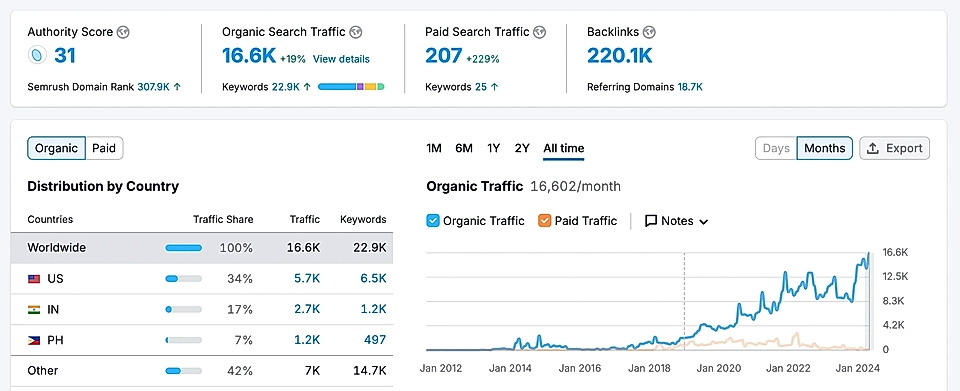
My favourite SaaS marketing channel is SEO, which, ever since Google took over the market, has been built on top of something called Page Rank. The older generation search engines like Altavista and Yahoo were based on topical link collections and later keyword matching.
Page Rank is Google’s key differentiator. In addition to the keyword match, the importance of a single page is evaluated based on Google’s secret ranking algorithm that takes into account, for example, the topic coverage on the same website and how many other sites link to the page. The more content links to your piece elsewhere, the higher authority your website will have in the eyes of Google.
Now, SEO is about to be disrupted again, just as Google did a couple of decades ago.
Because of the recent AI developments, search engines are getting more accurate, cost-efficient, and faster in evaluating the actual meaning of the content. It’s not that Google wouldn’t have used AI for quite some time, but the recent breakthroughs have made these capabilities available for startups to challenge the king of the search.
Search Ads
Google Ads is another favourite of mine. It’s always been the most predictable lead generation channel for SaaS.
It’s never been easy to tell how many visitors convert into leads and sign ups, but with Google Ads, getting the audience you want to your product landing pages has always been easy – assuming you’ve got the budget in your pocket 💰
For the past 20+ years, Google Ads for SaaS has been based on keywords and search phrases. Now, AI development is challenging that approach as well.
Instead of keyword searches, more and more services will start to place ads based on context and the information they hold about the user. Technologies that have previously only been available for Google and social media channels are suddenly at arm’s length for startups.
Social media
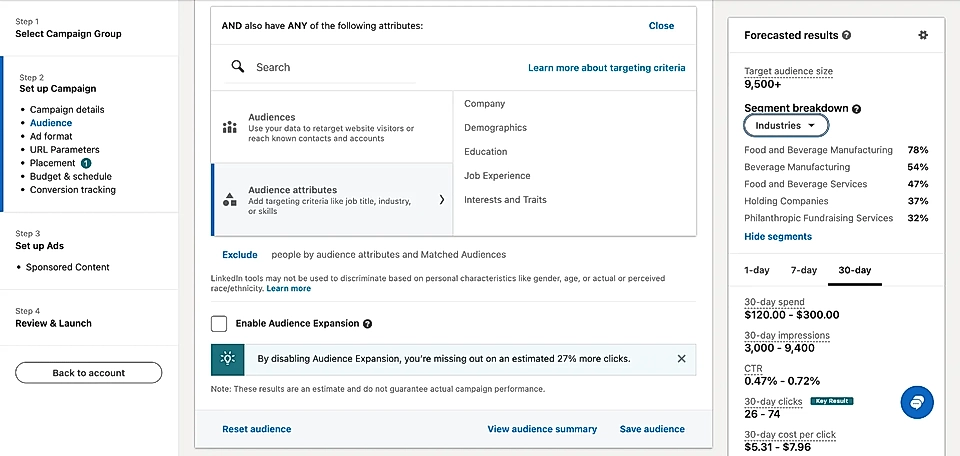
From SaaS marketers’ perspectives, I’d expect content distribution on social media services to be less disrupted than search traffic. If anything, audience-based targeting might only get better, and instead of relying on hashtags, we’ve already seen social channels recommend content based on contextual information.
I expect that B2B SaaS marketers will find completely new opportunities as the targeting gets even more accurate in services like Instagram and TikTok, which consumer brands have mostly used until now.
Direct outreach
Surely, even the traditional sales work is changing, but for the sake of this blog post, I’ll cover changes in email and LinkedIn outreach.
Email marketing is a big part of SaaS customer retention. In the past, mass emails were sent based on fairly static rules set in Mailchimp, Klaviyo, Intercom, and similar platforms. With AI, both the reasons why a message is sent and the actual content can be dynamic and personalized.
The same goes for cold emails and LinkedIn DMs at scale, which typically follow a set of rules. For example, the name and company are generated dynamically while the rest of the content is templated.
Now, AI services can fetch information about the lead and their company and then serve the best matching content from the SaaS website.
To make this all work optimally, you’ll need focused landing pages – a lot of them.
Three changes that disrupt SaaS marketing and what actions to take
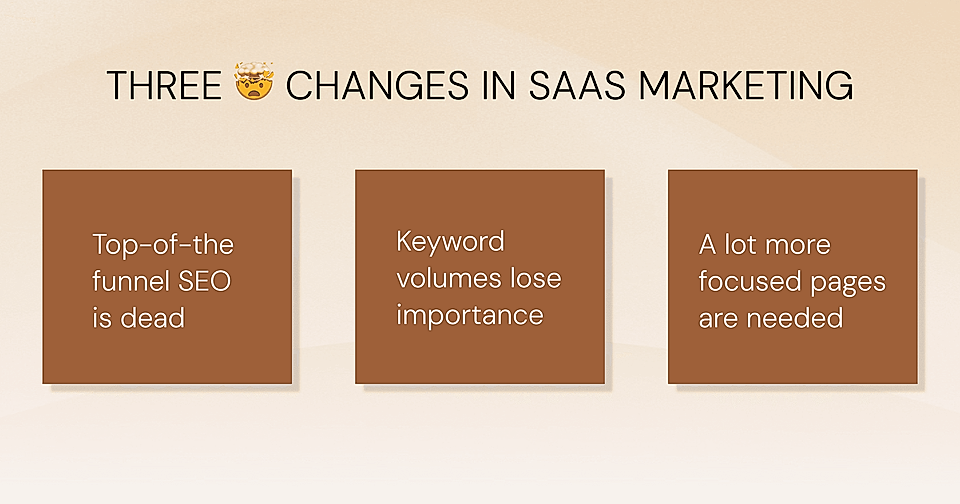
Technology can change, but it doesn’t necessarily cause drastic changes in what we do.
Take, for example, the rise of mobile devices. While e-commerce has undoubtedly changed massively, B2B SaaS marketers haven’t changed their strategies and tactics much.
But trust me when I’m saying that AI will change the SaaS marketing landscape radically.
Let’s take a look at the three top shifts we can anticipate.
1. Top-of-the-funnel SEO, as we know it, will be dead
Top-of-the-funnel simply means keywords that are the highest level searches like ‘SaaS marketing’. In comparison to the bottom-of-the-funnel traffic, people searching for high-level stuff are most likely not ready to buy your service just yet. On the other hand, the bottom-of-the-funnel traffic and users might be searching for something very concrete like the ‘best social media listening tool’.
Today, if you want to claim the #1 search result spot for the term ’SaaS marketing’, you’ll need to write a guide that covers anything and everything about the topic.
Before writing, you’ll need to study the top 10 content carefully and write something even better and more extensive to get a chance to knock one of the top 10 results out. Brian Dean, a content marketing guru, calls this tactic a skyscraper technique.
It’s not over yet, but you can see the change already if you know where to look.
If you type ‘SaaS marketing’ in Perplexity and compare it to Google, I’m 100% certain that you’ll choose Perplexity if you can keep just one tool in your pocket.
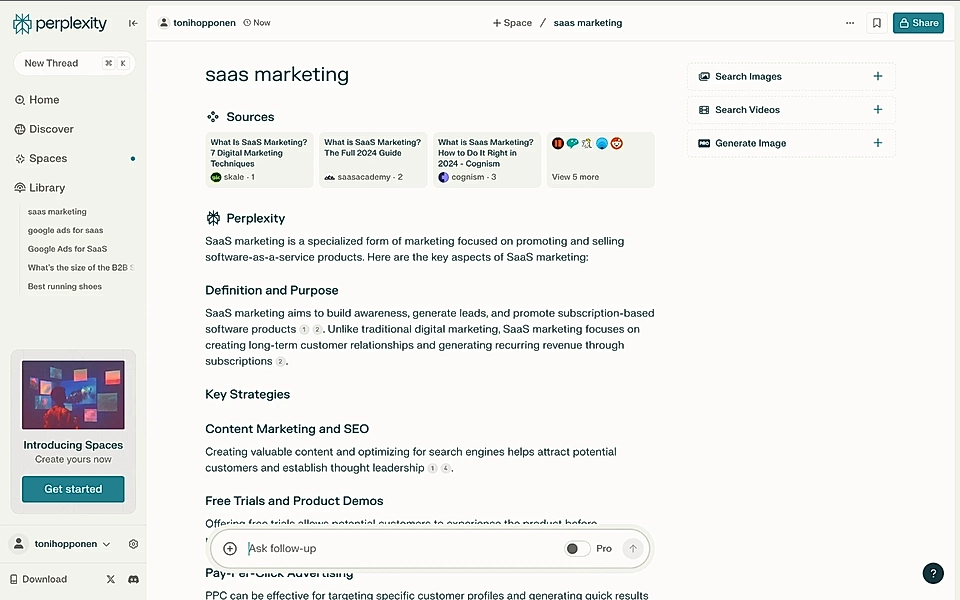
Instead of long-form content, Perplexity gives you a summary of the topic and allows you to dig deeper into the areas that you find interesting. You are not forced to read the whole piece to find something meaningful, and your journey can take unexpected turns.
It changes everything in the top-of-the-funnel strategy.
If the top of the funnel content for SEO is soon dead, what actions can you take?
AI services and large language models (LLMs) powering them are fantastic at summarizing complex information.
However, LLMs lack the details, experience, and examples that you can show in your specific domain. When a user opens ChatGPT, it’s powered by all the publicly available information and data the user has ingested, but the answers won’t ever be influenced by a certain SaaS company’s and their customers’ point of view.
When writing your next piece of content, think about how you can answer the top-of-the-funnel search term but add your angle to it. This will give you a chance to be included in one of the AI-generated summaries as one of the point-of-views outside the generic summary.
Writing to answer the top-of-the-funnel keyword with skyscraper method you can put behind.
By the way, this blog post you are reading right now has no chance of knocking out the top 10 results in Google for 'SaaS marketing'. Instead, it is trying to find its way to the AI-generated summary and parts that discuss future changes.
2. Content creation decisions shouldn’t be done based on keyword volume
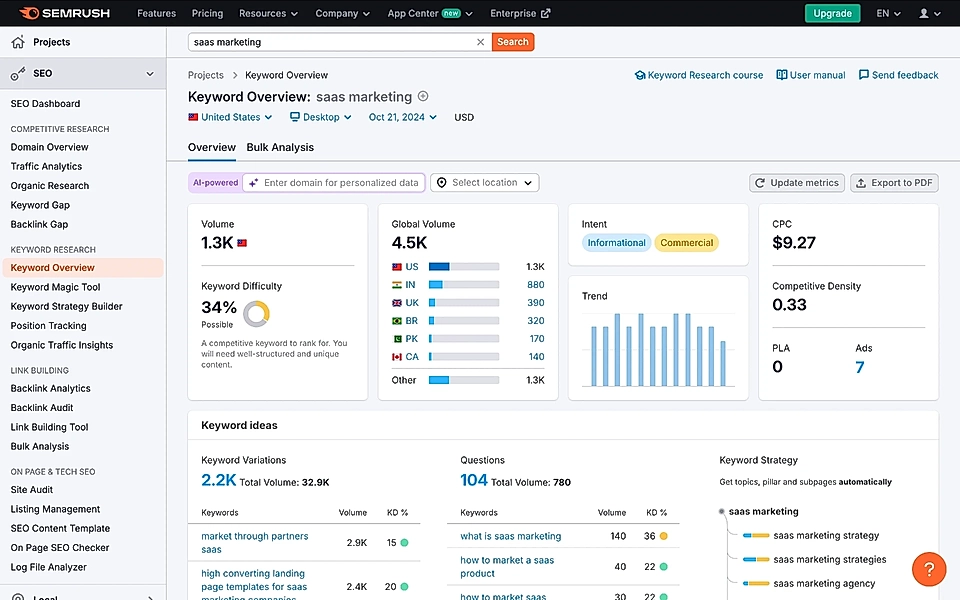
Most marketers decide on SEO and paid search content creation based on the keyword data provided by Semrush, Ahrefs, and similar tools.
And you should continue doing that – for now.
However, the more search results are shown as AI-generated summaries, the less keywords-driven tactics will matter in the future. New user interfaces allow users to start their journey with everyday language via text and voice.
For example, if someone in the future asks Perplexity to tell more about SaaS marketing and this article is recommended for learning more about the implications of those changes, what keyword is the user using? Is it the original, everyday question? Or is it the contextual link they clicked to arrive at this blog post?
You need to start planning your content creation from a customer value perspective.
Previously, you might have read your customer live chat scripts and feedback and then distilled them into keywords with high search volumes. Now, I believe you’ll need to go back to the same data and find repeating soundbites and patterns your ideal customers would likely use in ChatGPT, Perplexity, and Google.
Instead of making choices based on the keyword volumes, you should start generating content and landing pages for topics and keywords that SEO tools show no traffic for and are not your typical two to three-word search phrases. You must know what’s the “top of mind” for ideal customers right now.
3. You’ll need more high-quality and focused landing pages than ever before

If SEO and paid search are both on the way to transforming from keywords to more contextual and long tail, it can only mean one thing: you’ll need a lot of landing pages.
If you rely on the homepage, product, and pricing pages, you’ll have no chance of being included in search results, where AI picks sources based on the content match and user intent.
For example, if the user is searching for the best SaaS marketing tools in a specific industry, you’ll need blog posts and landing pages that directly answer the user’s intent – much more detailed than the AI can provide.
And when you are running cold email or social media advertising campaigns in the future, you want to have targeted and focused pages for the AI-assisted services to choose based on the recipient. Services like Instantly.ai already tailor the cold email text content based on the LinkedIn profile information – your SaaS website is most likely the weakest link in the highly personalized funnel, driving visitors to a generic homepage.
The most typical SaaS landing page types and the ones you’d want to consider building are:
- Solutions, features, and use cases
- Industries
- Job roles and functions
- Industries
- Competitor comparisons
Depending on your SaaS, some of those page types are more important than others. For more inspiration, learn what pages the best B2B SaaS websites include.
Conclusion
AI is certainly changing the SaaS marketing landscape more than the previous technological changes.
However, it is comforting that companies that take a long-term approach and focus on delivering customer value will also be the likely winners of the future.
These changes certainly mean that you will need more pages than ever before. More pages that you can’t necessarily create based on the keyword volume data. More targeted and focused pages to make sure you give your SaaS a chance to be featured in AI-generated summaries and the right context.
Are you having trouble creating landing pages? Perhaps you rely on designers and developers for help, and you are not getting pages live as fast as you’d want to. There’s an easy fix – sign up for our 14-day free trial to publish focused and targeted landing pages on your existing website at scale.